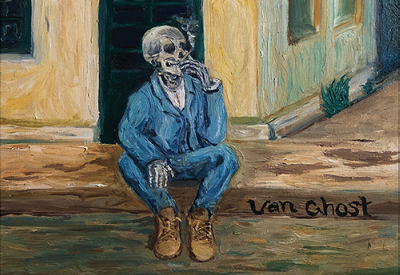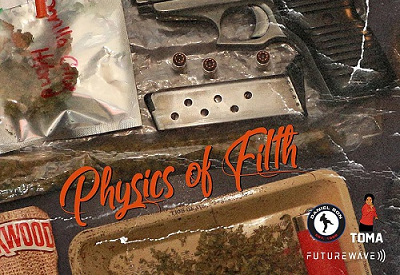by Rajin

9/10
Since delivering his official debut album in 2017, ANKHLEJOHN has remained one of the most interesting emcees in the current underground scene. He has a tendency to switch things up for each project, an artistic choice that continues to keep him fresh and engaging. He has released countless EPs and mixtapes, each of which has its own identity that sets it firmly apart from the rest of his discography. In June 2018, he released what he touted as his second album, Van Ghost, with legendary blogger turned full-time producer Big Ghost Ltd. Ghost has worked with Ankh before, supplying him with the most dynamic, cinematic beat on the entirety of The Red Room (“Original Man,” a chilling song that features Hus Kingpin). From their very first time working together, it was clear that Ghost had a deep understanding of who ANKHLEJOHN is as an artist. The chemistry that these two obviously had gave way to further collaboration, eventually culminating in an incredible album, inspired by Vincent Van Gogh.
Big Ghost initially made a name for himself as a producer on 2015’s Griselda Ghost with Westside Gunn and Conway. He took a fresh approach to the sound that Daringer had crafted for Griselda and made it his own, resulting in one of my favorite projects to ever be released by the label. From there, he’s continued honing his skill and developing his own musical identity. His distinct drum patterns and ear for samples make his beats instantly identifiable. What sets him apart the most, however, is the way he adapts his production to fit the rapper with whom he is working like a glove. While his sampling techniques generally don’t vary, the sources from which he draws change depending on the style of the emcee he’s producing for. This practice creates an entirely different sound for each project while maintaining an unmistakable production signature. Through his subsequent work with Vic Spencer, Hus Kingpin, and CRIMEAPPLE, he proved himself to be one of the most reliable producers in the game.
With this in mind, to say he outdid himself on Van Ghost would be an understatement. The production on this record is without a doubt the most unique and awe-inspiring music Big Ghost has created thus far. It’s actually quite difficult to describe; while still very obviously boom bap, the aesthetic brings to mind the image of a chapel designed in the era of Baroque architecture. Tracks such as “The Church at Auvers,” “The Starry Night,” and “At Eternity’s Gate” feature elements including pianos, angelic vocals, and harps that sound nothing less than godly, for lack of a better term. The majority of the production work on this album ultimately leaves the listener astounded at how Ghost pulled off what he did. In a moment of sheer brilliance, he bridged the gap between past and present on “Almond Blossoms,” another track featuring Hus Kingpin. The production weaves between sections with harpsichords and sections with bassier, jazzier sounds that recall the luxurious vibe of Cocaine Beach. It’s incredibly seamless, and it is just one of many examples that demonstrates level of creative ingenuity displayed by Ghost throughout this album.
Truly, the only rapper who could have done this production justice is ANKHLEJOHN. Anybody who is familiar with him knows how dramatic his style as an emcee is. The dark, creepy ad-libs that he throws into the mix serve as a stark contrast to the heavenly sounds found among the instrumental backing, and his gruff voice offers an often frightening element to otherwise soothing music. He elevates the already cinematic instrumentation to an entirely new level; on just the first track, which opens with some very melancholy pianos, Ankh soulfully recounts a story of past trauma, before switching to a threatening growl as the beat takes a turn for the horrific. This is representative of his performance through the entire album; he brought the best out of every beat with how he adjusted his vocals to match and compliment the feel of the instrumentals. The production on this album seems to have inspired Ankh to show more variety in his delivery, and as a result, this is potentially his most vocally diverse project to this day. Lyrically, Ankh has always been fairly blunt, and he doesn’t deviate from that here. Some songs serve as violent displays of blunt lyricism while on others he instead opts to drop knowledge, displaying the dichotomy often found within his music. In general, his style felt looser on this project than others, which ultimately served to benefit the final product.
I would be remiss if I didn’t mention the features on this album as well. Ankh shares the mic on only two tracks, on the previously mentioned “Almond Blossoms” with Hus and the posse cut “At Eternity’s Gate,” and each time it worked wonderfully. The latter is by far the greatest posse cut I’ve heard in years; with a lineup of features that includes Eto, Fly Anakin, and CRIMEAPPLE, one would think the track could never live up to the potential those names alone set. I’m happy to report that it likely exceeds anything anyone could expect.
With Van Ghost, ANKHLEJOHN and Big Ghost crafted the most original rap album I had heard in a long time. The care that went into it is evident even from the surface; each track is named after a Van Gogh painting, and Big Ghost himself painted the artwork in a similar artistic style that Van Gogh painted in. I’m going to acknowledge the obvious: this review is many months late. This is because I honestly had a hard time describing this album in a way that would do it justice. Everything came together in such a unique way. There was no precedent set for it, so I didn’t know what to say about it. In many ways, this album is peerless. You’re unlikely to see another project offer what this one does, in the same fashion that it does. For that reason alone, it’s worth a listen. It is detailed and layered to the point that most people are going to walk away having picked up something that others haven’t. In that sense it hits its mark entirely, acting as an equivalent to a fine painting.

